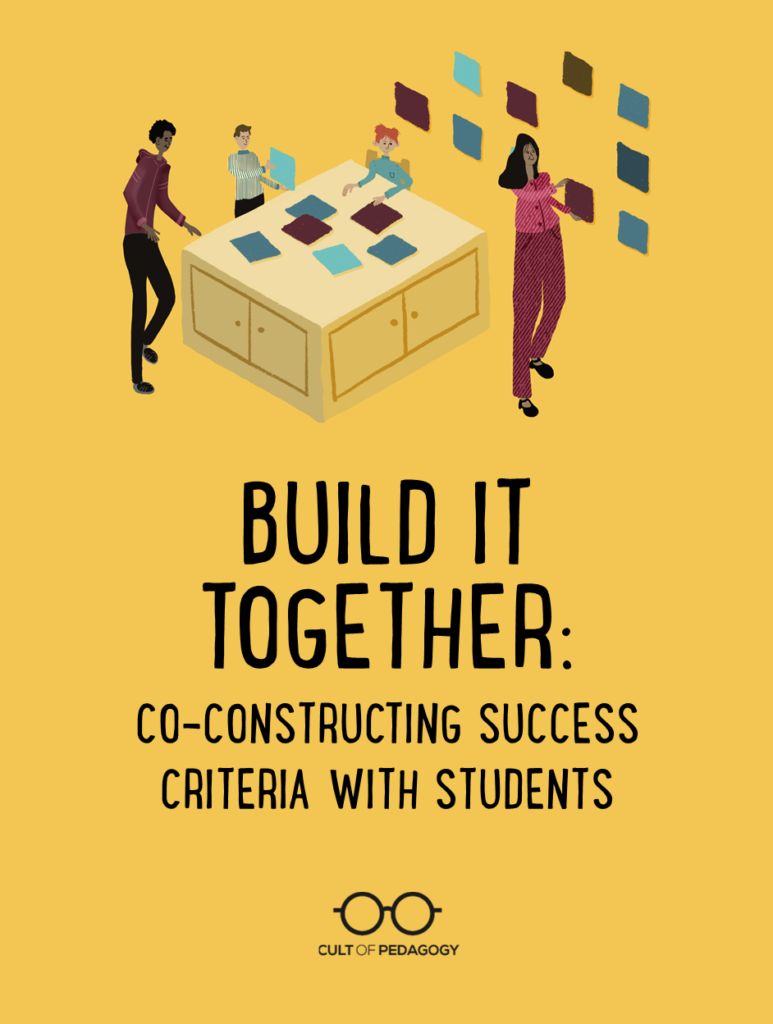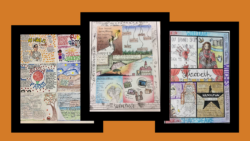
Listen to my interview with Starr Sackstein (transcript):
Sponsored by Hapara and TGR EDU: Explore
This post contains Amazon Affiliate links. When you make a purchase through these links,
Cult of Pedagogy gets a small percentage of the sale at no extra cost to you.
Early on in my teaching career I would spend entire weekends grading a stack of student papers, highlighting the accompanying rubric to indicate problem areas and writing comment after comment to point out strengths and areas for improvement. The following Monday, when I returned the papers, far too many students would look at their grades and feedback like it was written in another language. Despite the fact that I had gone over the requirements at the beginning and given them a copy of the rubric ahead of time, they acted like they were seeing them for the first time.
That was my fault. I had done a few things right—namely, making the requirements available from the start—but I hadn’t really done anything to make sure students understood them.
As I gained more experience, I added in a few more steps that helped: I showed students models of finished products, which gave them a much clearer picture of what they were shooting for. I also had them score a few samples to get them to pay closer attention to the requirements in the rubric. Both of these went a long way toward getting students to understand what they needed to do. But I knew I wasn’t all the way there yet; I just couldn’t quite figure out why.
After talking with Starr Sackstein, I think I found the last few pieces of this puzzle. Starr has spent the better part of the last decade fine-tuning the way she assesses students and helping other teachers do the same through her books, videos, and training. She was a very early guest on my podcast in 2015, where we talked about teaching without grades. In her new book, Assessing with Respect, she looks at assessment through the lens of social emotional learning. The book “addresses the five SEL competencies—self-awareness, self-management, social awareness, relationship skills, and responsible decision making—and explains how teaching students to develop their abilities in these areas can help them improve their learning and assessment experiences.”

One of the practices she recommends—the one that would have really helped me in the situation I just described—is including students in the process of defining what will be assessed, also known as co-constructing success criteria. In other words, rather than having the teacher be the only one who decides what constitutes good work, have the students contribute as well, and make them part of that process from the very beginning. Although I did some of the things that Sackstein recommends, I missed a few key steps that would have really made a difference.
What is Co-Constructing Success Criteria?
“It’s essentially backward planning with students for success,” Sackstein says. “We’re going over an assignment with them, and we’re having a conversation about what it would take to be successful on it.”
The term “co-construct” can be misleading because it implies that students are actually creating the assessment or developing the criteria from scratch, and this isn’t necessarily the case in every classroom. Teachers who are just getting started might fully develop an assignment, then only invite students to study its criteria carefully. What’s happening in these scenarios is more like co-constructing an understanding of the criteria, not building the criteria together.
Other teachers hand over more control to students, either building an assignment from scratch or starting with a draft, then inviting students to suggest additions or changes. “It really just depends on the kind of teacher you are and your comfort level,” Sackstein says, but if you ask for student input, be prepared to seriously consider it. “There needs to be an openness on your part to revise. If you’re going to invite kids into the process and they make valid suggestions, if you ignore them, that’s not going to win you any prizes with them.”
Why Involve Students in this Process?
If a teacher creates high-quality assessments with clear criteria, why would it be necessary to include students? Isn’t your own teaching expertise enough? Here are a few reasons why co-construction has value:
- You’re not as clear as you think you are. “I can have amazing ideas but sometimes how I communicate them in the assignments doesn’t always come out the way that I think they do in my head,” Sackstein says. “Early in my career, I would get work back from kids that didn’t even remotely look like what I was expecting. Sometimes we want to blame the kids, but it’s not their fault. It’s actually a teacher clarity issue, and this is one way to really solve that problem.”
- It improves instructional planning. While studying the criteria together, teachers can get a better sense of what skills students already feel confident about and where they feel they need more help. These insights can guide instruction for the unit.
- It improves students’ ability to peer- and self-assess. Having a clear understanding of the criteria and the vocabulary to describe it will help students do a better job of giving each other feedback and assessing their own work.
How to Co-Construct Success Criteria with Students
The main work of co-construction is done before an assignment starts. The practices listed below are shown as a sequence, but because each one feeds the others, teachers and students will likely find a natural flow that moves back and forth between all of them.
Don’t rush. For best results, devote at least a class period to co-construction. “If you have that clarity at the beginning,” Sackstein says, “the whole process is going to go a lot smoother. So slow down, spend an entire class period actually going over the assignment and working on developing the success criteria, and then get into the first part of whatever comes the next day so they’ve had time to digest it a bit.”
1. Unpack the standards and embed the language in everyday classes.
Even before you introduce the assignment—ideally, throughout the year—get students familiar with the standards that will drive your instruction and get them used to using the language of those standards.
“We talk about academic vocabulary a lot these days,” Sackstein says. “Kids have to be familiar with the language of standards. The way we do that is not only having learning targets that are directly aligned to them, but using that language in the lessons throughout.”
One way she does this by having students “unpack” the standards in small groups. Starting by giving students a standard to work with, “I’d ask kids to highlight the verbs, because the verbs are generally the skills, and then have them circle the nouns so that those are the concepts.”
From there, groups of students talk through their understanding of those skills and concepts and brainstorm what it might look like when a student does those things. They can also take it a step further and rewrite the standards in student-friendly language, also known as I Can Statements, which can be placed in visible locations around the classroom.
As the learning cycle progresses, the teacher can refer back to these statements, connecting them to the language of the standards, so everyone is familiar with and fluent in that language at all stages of the assignment.
2. Study and annotate the assignment.
At the beginning of a project or learning cycle, give students the prompt or assignment that they are going to be working on; this may also include a rubric (Sackstein prefers to use rubrics that only state the target criteria, like the single-point rubric). Have them read it carefully, annotating it by highlighting important words or phrases and writing comments or questions in the margins. The whole time they’re reading, students should be asking themselves, “What would success look like on this assignment?”
3. Study exemplars.
Right after studying the assignment, students should have the opportunity to look at exemplars, good examples of completed assignments. These can be teacher-made exemplars or real samples of work done by other students. Select or create samples that represent the highest quality; although it may be useful to show exemplars of lower-level work, these may not be as effective in the beginning. “You don’t want them to associate what success looks like accidentally by something that isn’t the highest quality.”
Give students some quiet time to read these, then maybe have them partner up to talk about what they’re noticing in the exemplars. Where are they seeing evidence of the criteria in the assignment? After students share with one another, come together as a class to identify places in the exemplars where the required criteria are demonstrated, using the language of the standards in this conversation.
This step really makes the success criteria come alive, helping students see exactly what it looks like when a student is meeting the standards well.
4. Identify instructional needs.
Once students have a clear idea of what’s expected of them in an assignment or project, the final step before getting started would be to have them identify where they are going to need instructional support from you. Which standards will they need to improve on? What skills and concepts do they need to learn in order to succeed?
Teachers can gather this information from the class as a whole by doing a teacher-led KWL chart, where students identify what they already know and what they still want to learn. Or they might poll students privately through an exit slip or Google Form.
“Then when you’re starting to plan your mini lessons,” Sackstein says, “you have a sense of where you need to start.” You might begin by addressing the needs identified by the highest number of kids, but also prepare other resources to personalize instruction for smaller groups.
Co-constructing success criteria is just one small part of Sackstein’s overall approach to assessment, which pushes back against traditional methods in favor of student empowerment.
“Fundamentally I think grades and other labels that we use in school are harmful to student learning because as educators, the person in charge had the ability and capacity to really shape the way a learner feels about themselves and that context,” she says. “So when they struggle in math and we say they’re not good at math or they struggle in science or they’re not strong readers when they start, they internalize that, and then it affects the way they go through the rest of their learning and potentially what happens after that as well.”
By including students in the assessment process, we help them take charge of their own learning. “Give very direct, instructive feedback, and make it an iterative process where student voice is a large part of how we assess them with reflection and self-assessment. That partnership between what’s going on for them as learners and what we’re seeing as educators comes together to help them start to set goals and move on, progress along their own learning.”
Read more in Sackstein’s book, Assessing with Respect or in one of her earlier works. You can also learn more from her on her website, mssackstein.com.
Join our mailing list and get weekly tips, tools, and inspiration that will make your teaching more effective and fun. You’ll get access to our members-only library of free downloads, including 20 Ways to Cut Your Grading Time in Half, the e-booklet that has helped thousands of teachers save time on grading. Over 50,000 teachers have already joined—come on in.





1. How do you solve the problem of students making their work look identical to exemplars?
2. How do you include innovation, and creativity, and thinking if you tell kids what the end product should look like?
3. What does “direct” feedback look like? How do you give “direct’ feedback without giving the answers and without students just copying/reiterating the feedback that you give them?
The exemplars serve as an opportunity to see what success looks like – you don’t use the same text or the exact same content. We want them to try to make things that share the same criteria.
We don’t speak in terms of exacts – there is room for what the product looks like and we encourage creativity by allowing students to interpret the success in a way that works for them.
Feedback should seek to help students improve – asking clarifying questions or identifying challenges and providing tips and/or strategies for improvement on the specific areas you want them to adjust. You should never just give them the right answer. I apologize if that is the way it came off.
I hope this answers your questions. If you have further questions, please email me at mssackstein@gmail.com 🙂
In my experience there will often be students who will rely on the exemplar when they are getting started in this process. My goal is to move them to a place where they feel the self-efficacy required to take a risk in producing something that is entirely their own. Relying on the exemplar can be important scaffolding for some students. Ideally, they will have many opportunities through the school year to improve their comfort and proficiency in shifting to this feedback and evaluation model, and to move away from relying on the exemplar.
I wonder if feedback can also look like directing students to a portion of their work or project where they had a “missed opportunity” to demonstrate a piece of the success criteria. This supports them to do their own thinking about what’s missing.
I often use exemplar for my students. I am learning how to not use them as much. It has helped a lot with student who are visual learners.
I do think that giving the feedback will help the students understand where they messed up or an area to focus on. I personally like that when my professor does it for me.
Thank you for this article! The discussion on rubrics and what does it look like is so relevant for teaching in Australia – we are provided with a set rubric for each subject that is used to determine an A-E grade for a broad group of assessments. We do not have the opportunity to build a rubric from scratch, but am thinking I will try to find a way to simplify the language of the rubric as a part of the unpacking activity with my students.
I am also thinking of scaffolding the activity depending on the year level – in Year7, students can be guided through unpacking the standards, and gradually release the activity so that by Year 10 students are working in independent groups and leading the discussion.
Even with a set rubric, you can go through the co-construction of success criteria together by exploring how the criteria will look in the learning. Get students to come up with “I can statements” that will show they understand what exemplary work looks like.
Unpacking standards together is a great idea:) I’d love to hear how it goes if you try it.
I am so happy to have received this note from your side Jenifer.
Learners co-constructing the success criteria through the I can statements to build upon the main idea of inquiry.
Also, what really inspires me is the significance of exemplars to guide students to identify what success looks like; a splendid takeaway once again!
Thank you Jenifer!
Enjoyed this. While there are MANY questions that arise whenever making a substantial paradigm shift, you did a great job showing how possible and necessary it is that we convey full citizen status to students and require them to weigh in on the process we are all engaged in.
My fav. moment was when you pointed out that assignments and rubrics and standards are themselves genres of (hopefully) non-fiction and therefore fair game for in-class discussion, quizzes, etc.
In fact, what better non-fiction text than one students are themselves the audience of and in which they have a stake.
Thank you so much for saying so. I think that we need to start reimagining how we bring students into this process and have to adjust our thinking on what constitutes reading 🙂
I really liked the article, thank you very much!
I’m from Buenos Aires, Argentina. I’m a History teacher, working in high school and trying to help other teachers improve their day-to-day practices.
I was wondering if I could translate this article into Spanish and then publish it (with your permission, of course) in my blog. You can consult it right here.
Thank you very much!!
Hey! It’s wonderful to hear that Cult of Pedagogy resources will be reaching a Spanish-speaking audience! Yes, you have permission to reprint the article in Spanish, as long as proper attribution is given to the author of the original post and you provide a link so people can read the original in English. Thanks so much for checking with us on it!
Of course I’ll do that! THANK YOU!
This is to let you know that the article was translated and published on my website. You’ll find the link in this comment.
THANK YOU VERY MUCH!
https://educacion-innovacion.weebly.com/
Thanks so much!
Hi Starr,
Thank you for this very accessible review of how to incorporate student voice and agency in evaluation.
What are your thoughts about co-constructing success criteria that is accessible and achievable for all? Considering learner variability in the classroom, how do we remove barriers to learning for all through co-constructed success criteria?
Hi Stephanie, thanks for reading and reaching out. I completely agree and support that success criteria should be appropriate for the students who are doing the learning. Success criteria can be differentiated depending on what we are hoping for the outcomes for each child. There are definitely ways to co-construct success criteria with individual students and/or small groups depending on students’ needs.
How can the use of learning objectives and success criteria impact student learning outcomes in classroom
Chinwe, if you haven’t already, you may want to take a look at the section of the post called “Why Involve Students in this Process?” This section outlines three reasons that co-constructing success criteria has value both for our instructional practice and for student learning outcomes. In addition, many of the steps included in the process of co-constructing success criteria, like unpacking the standards and studying exemplars, can lead to a richer student understanding of the content. If you’re interested in learning more, Starr has a website that you can access here, which contains a lot of excellent resources about assessing student learning.